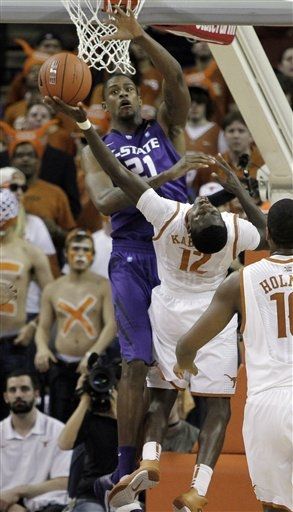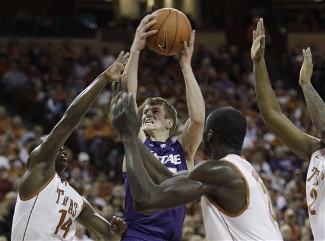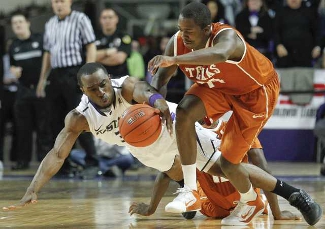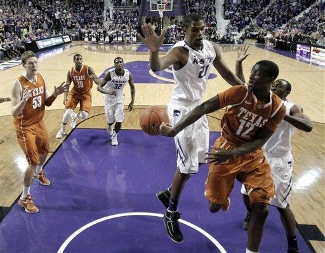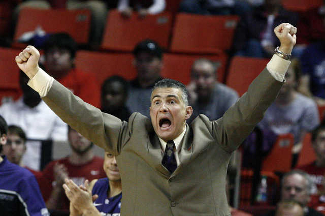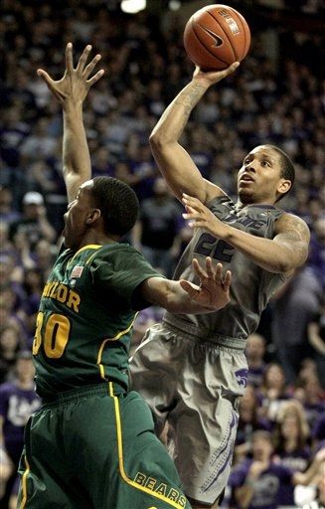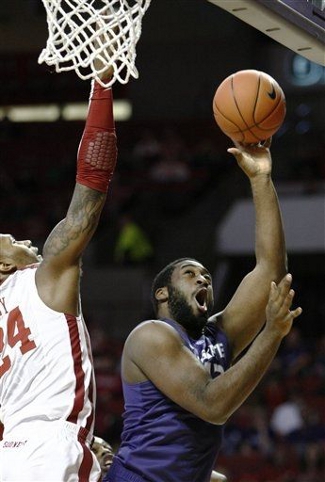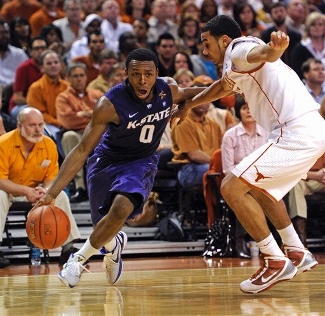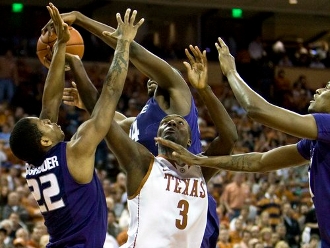As the Texas Longhorns headed to the locker room at halftime of Saturday afternoon’s game against Kansas State, it appeared that the hopes of a 14th-consecutive NCAA appearance could be circling the drain. The Wildcats had put on a late surge to build a 13-point lead heading into the break, thanks in large part to the fact that the Horns managed just two field goals in the final 16:28 of the half. The first possession of the second half started off promising, as Clint Chapman blocked a shot and the Wildcats missed a short putback. But then another offensive rebound led to an easy hoop for K-State, and suddenly Texas was in a 15-point second-half hole on a day where they had yet to even manage that many points from the field. Even faced with those daunting odds, the Longhorns stormed back and kept their NCAA hopes alive, powered by a surprise performance from the unlikeliest of sources.
Kansas State repeatedly sent Texas to the line With 16:30 left in the game, Alexis Wangmene threw down a dunk off a missed layup by J’Covan Brown, breaking a 12-minute field goal drought for the Longhorns and bringing the Erwin Center crowd to life. It cut the Kansas State lead to 10 points and kick-started an 11-0 run that put the Longhorns back in the game. Following Wangmene’s dunk, Texas outscored KSU by a 43-20 count the rest of the way, cruising in the final minutes to an incredibly important win. What looked good While Wangmene provided the turning point for the Horns, he also chipped in his first career double-double, posting 15 points and 13 boards on the afternoon. His performance went beyond the stats, as his little hustle plays kept Texas in the game during a dismal first half and helped to lock up the game in the second. He added two blocks and a steal, but his active hands on defense disrupted many more plays than that. The one possession that best exemplified Wangmene’s effort came in the first half when he was sprawled on the floor, stretched across the lane following a missed shot by Texas. Three Wildcats had chances to corral the rebound, but he kept tipping at the ball, knocking it out of their hands. Ultimately, a Kansas State player bobbled the ball out of bounds, giving it back to Texas on the baseline. He had no chance at actually securing the basketball himself, but Wangmene’s hustle forced a mistake by the opponents. That type of heads-up play defined Alexis’ performance on Saturday. Myck Kabongo had set the tone early for Texas, picking up where he left off in the team’s first meeting at Bramlage Coliseum. The freshman consistently attacked the paint, as K-State’s Angel Rodriguez once again couldn’t keep up with his quick first step. Myck scored seven of Texas’ first 11 points, and added an assist on a nice interior bounce pass for a Wangmene dunk. His impact was short lived, however, as he picked up his second foul midway through the first and spent the rest of the half on the bench. It took only three minutes of the second half for Kabongo to pick up his third foul, once again leaving the Horns without their point guard. Unlike the first half, the Texas offense remained aggressive with Kabongo off the floor, led by a revitalized Brown. The junior guard scored 15 of his 23 points in the second half, including a pair of buckets on nifty spin moves that froze Kansas State and electrified the crowd. Brown’s commitment to driving the lane and attacking Kansas State spread to the team, and the Longhorns took advantage of an officiating crew that was calling everything tight. The two teams were called for nine fouls combined in the first four minutes of the game, and as a result both squads were shuffling players thanks to foul trouble. With the Wildcat frontcourt reduced to a platoon situation, the quick, athletic Longhorn guards and wings continually put the ball on the floor and made the defense react, earning easier looks inside and 28 trips to the line in the second half. The Longhorns also continued their resurgence at the charity stripe, knocking down nearly 73% of their attempts for the game. In the first half, Texas was a questionable 13-of-20 from the line, but improved down the stretch when it mattered most. After making just 63.2% of their attempts in the games against Iowa State, Baylor, and Missouri, the Longhorns have made 75.5% of their free throws during their three-game winning streak.
The Longhorn defense smothered KSU in the second half While the aggressive play helped Texas storm back in the second half, the team’s dominating defensive performance made sure that Kansas State had no chance to stop the comeback. The Longhorns extended their pressure beyond the perimeter, with even Wangmene getting up in the shirt of K-State bigs when they would catch the ball on the arc. The Longhorns forced nine turnovers and held the Wildcats to just 32.3% shooting in the second half, while also shutting out top scorer Rodney McGruder for the final twenty minutes. Texas also dominated the glass, making sure that their solid defensive possessions weren’t ruined by second chances for Kansas State. Led by Wangmene’s breakout performance, the Longhorns limited the Wildcats to just four offensive boards in the final 19:31 of the game. In tempo-free terms, that gave K-State an offensive rebounding mark of only 21% in crunch time, a far cry from their season average of 41.9%. What needed work When a team puts on such an inspiring comeback to save not just a game, but also a season, it can be hard to step back and take a look at what went wrong. Still, there were a few issues for Texas, particularly in the team’s flat first half. The two first-half fouls by Kabongo were incredibly frustrating for Longhorn fans and coaches alike. The first came on a charge when he pushed the tempo into a trap, while the second was a hold on an inbounds play. While both likely wouldn’t have been called in a game where the refs weren’t working so hard to keep things under control, Kabongo needs to adjust to the situation. The Longhorns need him on the floor, so he can’t be picking up fouls on offense or when the ball isn’t even in play. Without the freshman point guard on the floor, the Texas offense fizzled in the first half. As has been the case on many occasions this season, the Longhorns stood around, making lackluster cuts and setting weak screens. This team has shown that they can score without having both Brown and Kabongo on the floor, but fail to do it with any consistency. It seems at times like the youngsters just forget what they have to do off the ball to make the offense work. Fortunately, the halftime adjustments in this game were perfect. The Texas coaching staff apparently said all the right things in the locker room, and the players took it to heart. The Longhorns have made it a habit to dig themselves deep holes in conference play before typically storming back late in the game. For much of the season, that has resulted in close losses. Although this time the team was able to salvage the win, it would be great for the hearts and stomachs of Longhorn Nation if the team could play solid first-half basketball in the future. The big picture The win levels Texas’ conference record at 6-6, establishing a tie for fifth with Kansas State. If Texas wants to claim fifth-place at season’s end, they will likely have to do it outright. With the two teams splitting their regular season games, the tiebreaker will come down to who has beaten a team higher in the standings. At the moment, K-State holds the edge by virtue of their home win against Missouri. Even if Texas beats Baylor, there’s little chance that the Bears will jump the Tigers in the standings. If Texas can take care of business on the road in Oklahoma this week, their chances of finishing all alone in fifth are very good. The Wildcats now embark on a tough three-game stretch against Kansas, Missouri, and Baylor, with the latter two games coming on the road. If K-State can’t come up with some upsets, Texas has an excellent opportunity to make a big move in the standings. Outside of the conference race, this game was also huge for Texas’ bubble prospects. The Longhorns have a favorable back-half of the league schedule that allows them to build momentum, but they also have a rather weak tournament profile. Texas owns just two wins against the RPI Top 50, with those coming at home against Temple and Iowa State. While the Wildcats will likely finish outside of that group, Top 100 wins are also used by the NCAA Selection Committee, and the Longhorns had yet to record a victory against teams ranked 51st to 100th. Winning games against Oklahoma State and Texas Tech wouldn’t impress anyone, so the Horns had to have this W. With other bubble teams faltering over the last week, Texas now just needs to win the games it is supposed to. A loss in one of this week’s road games wouldn’t be deadly, but would certainly be damaging. What would be crippling is a sweep in the state of Oklahoma, which would put Texas back on the wrong side of the bubble with work left to do in the final three weeks. While the Horns earned a win they had to have on Saturday, they can’t afford to let their guard down as they hit the road. Up next: at Oklahoma (13-11 overall, 3-9 Big 12) |








